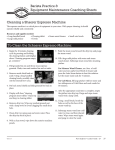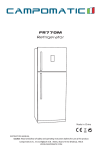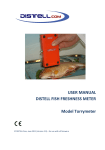Download Troubleshooting Espresso
Transcript
Troubleshooting Espresso To understand how to troubleshoot our espresso shots, we need to understand what we are looking for. Here is a short definition of what espresso is: What is Espresso? Espresso is a full-flavored, concentrated form of coffee that is served in 30 ml “shots.” Espresso is made by forcing pressurized water through very finely ground coffee beans, at 85-95 degrees temperature, extracting in that process the aromatic oils, the sugars and the soluble out of the bean. Ideally, espresso should have a thick, reddish-brown crema, a potent aroma and balanced in flavour between the sweetness, the bitterness and the sourness, leaving a lingering after taste on the tongue minutes after drinking. What does it take to Make Good Espresso? 4 Ms of Espresso Miscela (Blend) Macina (Espresso machine) Macinino; Macinadosatore ; Macinacaffe (Grinder) Mano (You) Assuming that your equipment is capable for maximizing espresso flavor and that your beans are roasted for espresso and are fresh, the area to focus on troubleshooting your espresso will be The Mano – You. We use skills learned at our coffee making training to operate a machine and a grinder to achieve consistent quality espresso. To produce a great coffee, science and art come together. Espresso production might be considered a science: if a number of variables such as grind, dosage and tamp are taken into account, you can produce a good espresso. The artistic side comes with milk texturing. But what happens if it doesn’t come out the way it should? 1. 2. 3. 4. Espresso pour is much slower or much faster than 25ml in 25-30 seconds Espresso pour is thin with little body or bubbly, gassy and unstable Espresso has non or pale, thin crema instead of Caramel color or red-brown Espresso is watery instead of having a rounded mouthfeel and a good body 2 5. Espresso isn’t balanced, it presents too much acidity or bitterness, could also taste rancid, medicinal or astringent Over extraction: If we get slow pour, e.g 30ml in more than 30 seconds, it takes a long time for the first drop to come out, it has a dark color throughout, thin crema and burnt, astringent and unbalanced taste: we are over extracting the coffee. We have created too much pressure that resulted in prolong contact of the hot water with the grinds thus burning it. What to do? Adjust your grind courser. Under extraction: If we get very fast pour with 30ml in less than 20 seconds, the crema pales quickly, it gushes out, thin and with fast dissipating crema, acidic or sour taste, thin and unbalanced mouthfeel, than we need to increase resistance. What to do? Adjust your grind finer. Uneven extraction: If the mouse tail shows 2 different crema colors, if there is a dark rim around the crema in the cup, if you find some loose grind on top of the crema, if flavor is unbalanced, we might be experiencing uneven pressure rate during extraction. What to do? Distribute the grind better. Uneven particle size can be a result of a grinder’s design fault or clumping. Clumping can be attributed to the grinder’s chute design or slow speed, as well as to changes in the weather (humid day result in more clumps) and the freshness of the coffee (the older the beans are, the more it will ‘sweat’). As the grinds clumps, water will flow faster through the air pockets created in between the particles, while the water flowing through the clumps will meet higher resistance and will flow slower, this will result in uneven extraction. If the beans and grinder are fixed factors, you can try and avoid ‘channeling’ or uneven extraction by paying attention to your distribution. Di Bartoli Copyright @ All Rights Reserved. The content of this document cannot be copied, edited or reproduced in any form without the prior consent of Di Bartoli. 3 After dosing as recommended below, you can choose any distributing technique known to you, as long as you keep it consistent. You can choose the North, South, West, East technique, or the twist technique, aiming at breaking clumps and distributing the grind as evenly as possible in the basket. Here are some more valuable tips: 1. Always wipe your basket dry before loading coffee 2. Use consistent dosing technique. The most popular one is: - Fill basket 3/4 high with ground - Tap twice the portafilter on the bench to settle the grinds - Refill basket with ground coffee until a mound forms on -Level by brushing off the excess coffee grinds with a dosing tool or your finger 3. Tamp in a consignment pressure maintaining level tamp. The right tamping pressure is the one you can become repetitive with. To updose, or not to updose? Updosing (loading more ground coffee than what is specified for the basket) seems to be a very popular practice with Australian baristas. Whether or not you can updose will be determined by how low your shower screen hangs down the group. lf it's possible to updose with your group design, whether or not you wish to updose will depend on your taste preference in relation to the blend, grind, the extraction rate, etc. Di Bartoli Copyright @ All Rights Reserved. The content of this document cannot be copied, edited or reproduced in any form without the prior consent of Di Bartoli.








